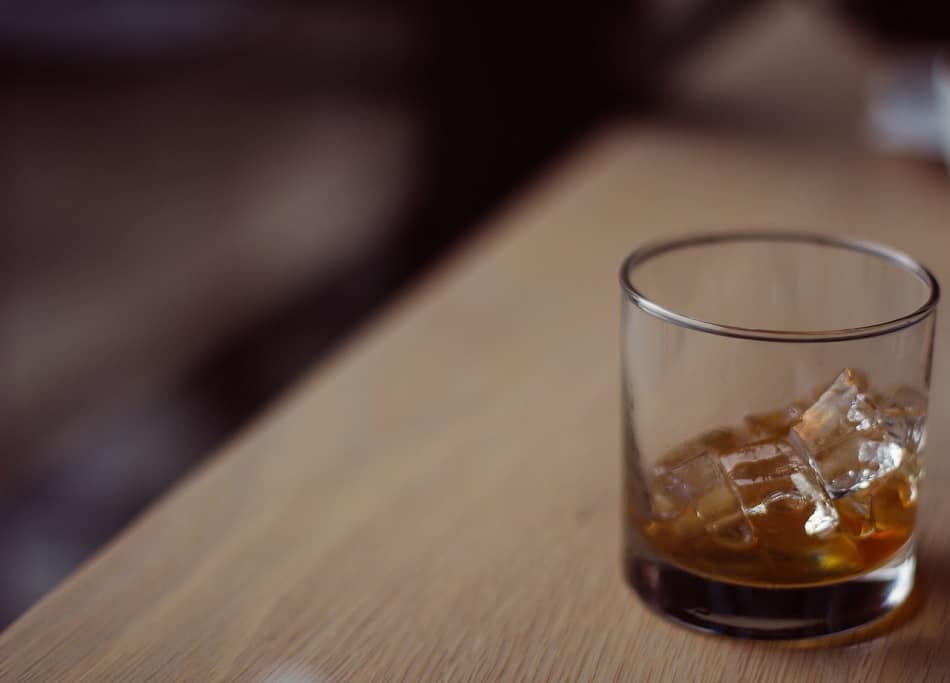Many people prefer whiskeys that are smooth especially beginners who are not used to a whiskey’s harsher elements. However, since people’s tastes are different there will be different ways in which a whiskey can be smooth.
There are in fact three ways a whiskey can be smooth:
- When the alcohol isn’t too harsh and doesn’t burn
- When the whiskey has soft flavors
- When the whiskey has flavors that work well together
Once we understand the three ways a whiskey can be smooth in more detail, we’ll know what steps we can take to make a whiskey smooth and when there aren’t any such steps, which whiskeys will be smooth and which will be more rough.

1. Whiskey Is Smooth When the Alcohol Doesn’t Burn
The first way for a whiskey to be smooth is when the alcohol isn’t too harsh and doesn’t burn you as you drink it.
The only problem with this is whiskey has an alcohol content of anywhere between 40%ABV to 68%ABV, which means that it is likely to be harsh and burn you as you drink it.
Actually, alcohol doesn’t burn at all in the ordinary sense. What happens is that it absorbs some of the moisture from the cells that react to the temperature of food and drink in the mucous membrane that lines your throat. This makes them more sensitive than usual and causes them to activate their this-is-something-hot signal, when the whiskey’s only room temperature.
Fortunately, this type of non-smoothness can be reduced. There are several ways to deal with the impact of the alcohol, turning your harsh whiskey into a more smooth one.
Don’t Inhale Before Drinking
Since breathing in just before you drink whiskey draws the alcohol vapors to the back of your throat and the delicate mucus membrane that lines it, if you don’t do that the whiskey will burn less.
Before you drink, inhale or exhale partially – it depends where you are in your breathing rhythm, but the point is to have some breath in your lungs. Your lungs shouldn’t be completely full or completely empty. Take a sip of whiskey and then exhale. Wait a few seconds before inhaling.
Use a Proper Whiskey Glass
Whiskey glasses are designed to reduce the impact of the alcohol and maximize your enjoyment of the whiskey’s aromas and flavors. Proper whiskey glasses or nosing glasses are tall with a wide bowl, a long narrow neck, a thin stem and a broad pedestal.
Nosing glasses lets air get to the whiskey allowing it to breathe. Some of the ethanol will therefore evaporate before you drink, reducing the whiskey’s burn. With other types of glasses less ethanol evaporates, so you can expect the full power of the alcohol and its harshness when you drink your whiskey.
One of the most popular whiskey glasses is the Glencairn Whisky Glass which you can find on Amazon here.
Dilute Whiskey With Water or Chill It With Ice
Diluting your whiskey with water to 35% ABV and reducing the level of the alcohol will make it burn less and the whiskey much smoother. It’s that simple.
Chilling your whiskey with ice cubes also reduces the harshness of the alcohol. The ice cubes lower the temperature of the whiskey which diminishes its intensity, and the burn of the alcohol is reduced. As the ice cubes melt, they also dilute the alcohol, reducing the burn further.

Acclimatize Yourself to the Alcohol
The previous approaches to dealing with the impact of the alcohol so you could turn your harsh whiskey into a smooth one, worked by reducing the amount or intensity of alcohol that you drink. This approach works the opposite way by making you less sensitive to the alcohol.
There are a number of things you can do to achieve this, and it will depend on your personal tolerance level.
It could be as simple as using the first smell and taste of each whiskey drinking session to acclimatize yourself to the burn of the alcohol or training yourself over a couple of weeks to become used to it. It could even be both.
Acclimatizing yourself with the first smell and taste of each whiskey drinking session is done as follows:
Nose your whiskey gently so that your nostrils don’t get singed by the alcohol. Open your mouth slightly as you inhale to let the alcohol fumes escape. Nose your whiskey again. Now you’ll be used to the strength of the alcohol and it won’t prevent you from being able to smell some of the whiskey’s aromas.
Similarly, when you taste your whiskey, drink a little sip first so that your mouth can also get used to the alcohol. The first sip will taste overwhelmingly of alcohol but with the second sip you’ll get more of the whiskey’s flavors.
Acclimatizing yourself over the course of a couple of weeks is done by repeatedly exposing yourself to the alcohol until you become used to it and react to it less.
There are two ways to do this. The first is by pouring yourself a whiskey, diluting it until it only burns a little and then drinking it. Do this for two weeks adding less and less water each day, and you’ll find whiskey will become smoother.
The second technique for acclimatizing yourself over the course of a couple of weeks is to drink whiskey every day until it stops burning and becomes smooth.
2. Whiskey Is Smooth When It Has Soft Flavors
The second way a whiskey can be smooth is if it has soft flavors. This in turn will depend on what grain is used to make the whiskey, how the alcohol is distilled, how long the whiskey is aged for and whether there are any additives.
The Grain Used to Make a Whiskey
The grain used to make a whiskey will help determine whether the final flavor will be soft and smooth or more harsh. Whiskeys made from malted barley are sweet and can be very smooth. Whiskeys made from corn are sweet, whiskeys made from rye are more spicy and whiskeys made from wheat are soft.
How the Alcohol Is Distilled
During fermentation when sugars are turned into alcohol, a small quantity of by-products are formed some of which can have unpleasant and harsh flavors. During distillation, the alcohol is purified but so are they. Several factors of the distillation process will determine whether these unpleasant and harsh flavors will remain or be removed.
1. The Material the Stills Are Made From
Pot stills are made from copper which helps strip spirits of unwanted flavor and aroma compounds that would make it unpleasant to drink.
2. The Number of Distillations
The more times a whiskey is distilled, the higher the proof it reaches, and the more flavors, both good and bad, will be removed. It makes sense — more ethanol in the solution means less room for congeners – the flavor-containing compounds.
3. The Cut of the Distillate
There are three parts to the distillate. The first part is the foreshoots or the heads which are high in alcohol and may be dangerous to drink. Alcohol from the end, the feints or tails, are weak but both the heads and the tails are pungent and not great taste wise.
Only alcohol from the middle or the heart of the distillation is used because it’s tastier, but precisely how this is cut varies from distillery to distillery and will affect the flavor of the whiskey. Wider cuts are done to reduce the cost of production but leaves in more of the unpleasant and harsher flavors.
4. Whether the Distillate Is Filtered
If the distillate is filtered through charcoal or another type of filter, impurities, large molecules and heavier oils can be removed, making the whiskey smoother. On the other hand, filtering may leave its own compounds.
How Long a Whiskey Is Aged for
Whiskey is aged in barrels so that it can pick up flavors from the wood. However, at the same time chemicals from the wood remove some of the unpleasant sulphury notes and some of the lighter and more volatile compounds evaporate through the barrel walls – otherwise known as the angel’s share. The upshot of this is that some of the whiskey’s harshness is removed, making it smoother.
In general, the longer a whiskey spends in the barrel, the smoother it will be. However, one can go too far in the opposite direction and too much time in the barrel can leave a whiskey tasting astringent which is not smooth at all.
Whether There Are Additives
Some countries allow the addition of flavorings, sweeteners, and blending agents in at least some of their whiskey categories. These can definitely make whiskeys taste much smoother.

This type of non-smoothness cannot be remedied. The only thing you can do is make sure you buy a soft flavored whiskey in the first place. Fortunately, there are lots of whiskeys out there and you’re bound to find at least twenty that fit your level of smoothness, but here are two tips:
Grain whiskeys which are distilled to a higher ABV than malt whiskeys so more of the unpleasant flavors will have been removed, are therefore more likely to be smooth. Many whiskeys are blends of grain and malt whiskeys so the smoothness may depend on the ratio of each.
Irish Malt Whiskeys are distilled three times (in contrast to Scotch Malt Whiskeys which are usually only distilled twice). The additional contact with the copper of the pot still makes Irish Malt Whiskeys much smoother.
3. Whiskey Is Smooth When Its Flavors Work Together
The third way a whiskey can be smooth is if its flavors work well together.
A smooth whiskey means one that’s well balanced, where nothing is too prominent, everything is well integrated and all the aromas, flavors and the structure work harmoniously together.
Ensuring the flavors work well together is especially important in blended whiskeys which are a mixture of anywhere between 15 and 60 individual whiskeys from different distilleries. With each whiskey having maybe several dozens of flavors, the master blender has his work cut out to create a whiskey whose flavors are well-balanced and work well together.
This type of non-smoothness also cannot be remedied but once again finding many smooth and well-balanced whiskeys amongst the many available is a relatively easy and enjoyable task.
